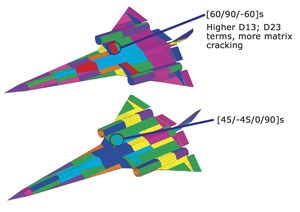Posted on 7/1/2006
Source: Composites World
The U.S. Air Force Research Lab (AFRL) Air Vehicles Directorate is pursuing high-speed aerospace system concepts that include the LRS (Long Range Strike) aircraft. The LRS is to fly at Mach 3.5 and is in the concept definition stage, planned for military utility in the 2020+ timeframe.
The U.S. Air Force Research Lab (AFRL) Air Vehicles Directorate is pursuing high-speed aerospace system concepts that include the LRS (Long Range Strike) aircraft. The LRS is to fly at Mach 3.5 and is in the concept definition stage, planned for military utility in the 2020+ timeframe. The lab’s goals are to accelerate maturation of aerospace vehicle designs, using lightweight structural concepts, and to enable the inclusion of detailed design information in trade studies that typify early steps of design evolution. Toward those ends, Collier Research Corp. (Hampton, Va.) recently employed its HyperSizer stress analysis/sizing optimization software to obtain optimal composite layups for LRS aircraft. The figure shows a subset of the finite element model (FEM), defined as an assembly that consists of external surface panels. This assembly includes four groups and 84 components, for which trade studies were performed, using three different methods of panel fabrication: honeycomb-cored sandwich construction, stiffened panels and thick, solid laminates. Many materials systems were included, with results displayed based on a baseline material that has publicly available AS4/3502 properties.
The AFRL had 42 different layups to choose from for the carbon fiber/epoxy facesheets and 27 different thicknesses were considered for the Nomex honeycomb core, ranging from .05 inch to 2 inches (1.27 mm to 50.8 mm). The HyperSizer progressive optimization process ended at a preliminary design that included explicit ply-by-ply layup sequences. The next level would have included ply drop-off blending across adjacent surface components. The accompanying illustrations contrast the optimum layup using two different analysis approaches to drive optimization. The first (top figure) shows results when traditional deterministic analysis was used. The second (bottom figure) shows results from probabilistic analysis (reliability). Deterministic analysis assumes that there is only one answer and it can be determined, says Collier Research president Craig Collier. Probabilistic analysis assumes that there are many answers and that the best answers are statistically found, based on additional correlation to test data. Probabilistic optimization, therefore, provides greater reliability and avoids layups that have higher D13 and D23 stiffness terms. Collier notes, “These are the mathematical off-diagonal matrix terms that represent coupling of behavior — in this case, undesirable coupling, say, between bending and shear-twisting deformation, which cause analyses to be less accurate and produce undesirable warping of the part after cure.” In all, 130 composite test data points were collected to derive two correlation factors — one for test scatter and the other for analysis inaccuracy. (This included data points from the World Wide Failure Exercises, an important set of recent publications that contain test data and the blind analysis predictions of the world’s leading composites experts.) Collier says the design optimized by this method will produce an airframe that is not only safer and more robust but also lighter than could be conceived using an optimization based on deterministic analysis. The latter does not acknowledge or individually take into account each analysis inaccuracy, Collier explains. Instead, it arbitrarily applies a 1.5 ultimate safety factor to all failure analyses.
Following the probabilistic analysis, Collier used Hypersizer to perform a progressive analysis. While Probabilistic analysis provides more consistent analysis accuracy, Collier explains that progressive analysis yields greater detail and deeper insight into failures. Composite strength was based on several methods, including 1) equivalent orthotropic approach, 2) laminate allowables using angle minus load (AML), 3) ply-by-ply analysis and ply allowables, using quadratic theories and open-hole-tension (OHT) and after-impact-compression (OHC) allowables, and 4) physically based composite strength theories, such as LaRC03, which model separate failures for the matrix and fibers. The analysis for the sandwich panels included facesheet wrinkling and dimpling; core shear; crimping; crushing from concentrated force; flexural bending; and joint support. Joint analysis of the stiffened panel bond between skin and stiffener flange computed peak interlaminar shear and peel stresses for predicting damage initiation with 13 unique failure criteria for the laminate adherends and six for the adhesive. “The ability to perform the depth of progressive failure analysis very rapidly with the non-FEA methods greatly improves the maturity of the design even during preliminary stages,” says Collier.

